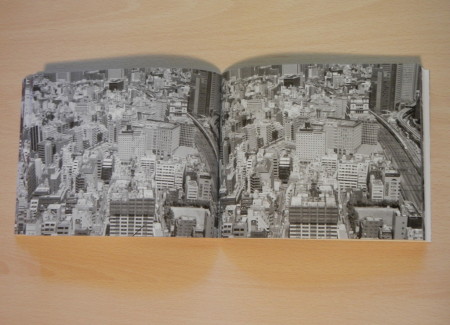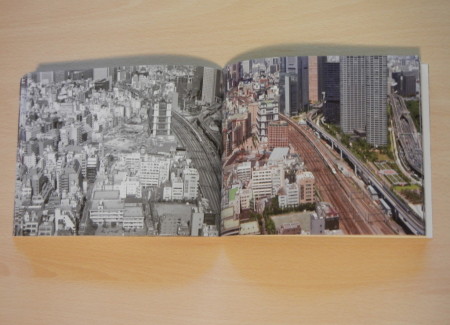JTF (just the facts): Published in 2013 by Akaaka Art Publishing (here). Softbound, 112 pages, with 97 black and white/color photographs. The book also includes an essay in Japanese and English by Shino Kuraishi. (Spread shots below.)
Comments/Context: At first glance, Taiji Matsue’s new book TYO-WTC might seem baffling – in page after page, a dense warren of nameless Tokyo streets is seen from above, and if you flip through them quickly enough, all the images will merge into one indistinct blur of seemingly identical nondescript buildings. But don’t put the book back down on the display table, wondering who would publish such an apparently dull collection of photographs; sit down and slowly look at each image in sequence and the conceptual framework of this project will quietly reveal itself.
When we think about photographing time, the simplest solution is a before and after pairing of two images, where we we can compare the two photographs and remark on the changes that have occurred in the interval between the two shutter clicks. Time flows forward, like the arc of a narrative, and a single point of view provides us with enough information to draw conclusions about what has happened.
Matsue’s elevated views of Tokyo question this whole premise and introduce a more complicated way of seeing time photographically. Over a period of several years, Matsue made images of the city from basically one location, employing four alternate views taken from roughly the same spot. Making pictures in both black and white and color, he documented the never ending transformation of vacant lots into apartment blocks and business towers, witnessed the destruction of old buildings and the rising of new ones, and captured hundreds of tiny changes (the growth of trees, the painting of an exterior, the addition of satellite dishes, a day with light snow cover etc.) to the landscape of this urban neighborhood.
But instead of laying them out end to end, in one long linear chain of subtle differences, he has organized them a series of paired diptychs that flow in a lilting forward and back rhythm. Starting with one vantage point, he slowly moves forward in time (a new building sprouting up, changing the geometric relationships to those around it), and then reverses, the intermediate construction steps unwinding step by step. He then switches the angle of view just slightly, jumps from black and white to color, and repeats the out and back process, allowing us to see the same story of destruction and construction replayed. This process happens four times, upending the idea that time is a one way chronological progression. Seen this way, Matsue’s version of time is something more continuous, like the in and out motion of reeling a fishing line or the play and rewind of a cassette tape. Construction starts, finishes, and starts again in a transient evolving flow, the minute differences from image to image helping us to follow which way we are travelling. Together, the images pile up into a larger essence of the breath of life in the city.
Even though these pictures have been executed with rigorous precision, Matsue’s visualization of photographic time is altogether less strict than our usual notion of storytelling. It’s more like a meditative accumulation, where if we look closely, we can track time in sweeps and twists. Anchored by the simple up and down of an apartment building, we become acutely attuned to the world shifting around us. This small unassuming book will likely be overlooked by many, but those that invest the effort to carefully follow Matsue’s lead will be rewarded with a rich example of innovative photographic thinking.
Collector’s POV: Matsue’s work is represented in New York by private dealer Amador Gallery (here) and in Frankfurt by L.A. Galerie (Lothar Albrecht) (here). His work has not been widely available in the secondary markets, so gallery retail likely remains the best option for those collectors interested in following up.












